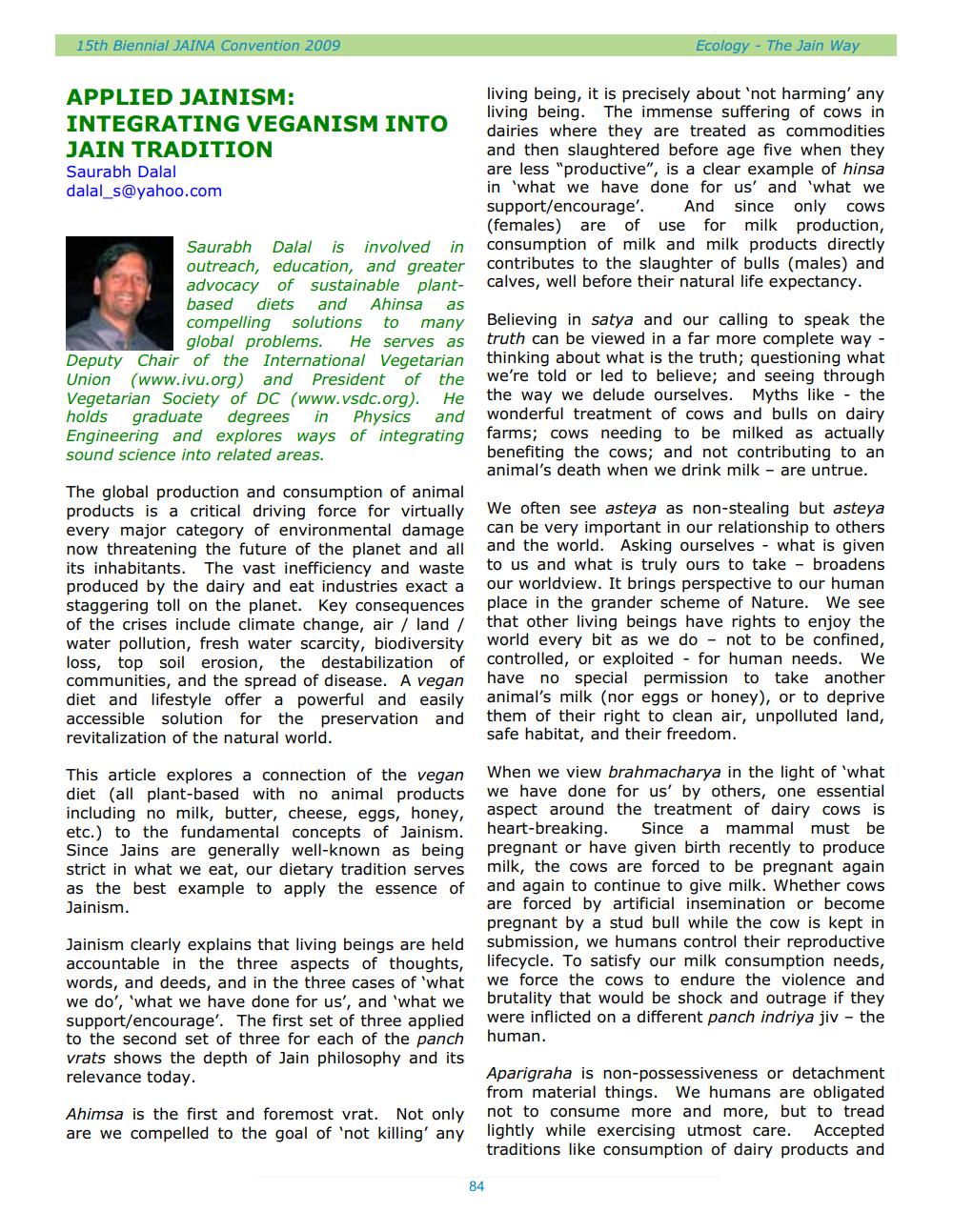________________
15th Biennial JAINA Convention 2009
APPLIED JAINISM: INTEGRATING VEGANISM INTO
JAIN TRADITION
Saurabh Dalal
[email protected]
Saurabh Dalal is involved in outreach, education, and greater advocacy of sustainable plantbased diets and Ahinsa as compelling solutions to many global problems. He serves as Deputy Chair of the International Vegetarian Union (www.ivu.org) and President of the Vegetarian Society of DC (www.vsdc.org). He holds graduate degrees in Physics and Engineering and explores ways of integrating sound science into related areas.
The global production and consumption of animal products is a critical driving force for virtually every major category of environmental damage now threatening the future of the planet and all its inhabitants. The vast inefficiency and waste produced by the dairy and eat industries exact a staggering toll on the planet. Key consequences of the crises include climate change, air/land/ water pollution, fresh water scarcity, biodiversity loss, top soil erosion, the destabilization of communities, and the spread of disease. A vegan diet and lifestyle offer a powerful and easily accessible solution for the preservation and revitalization of the natural world.
This article explores a connection of the vegan diet (all plant-based with no animal products including no milk, butter, cheese, eggs, honey, etc.) to the fundamental concepts of Jainism. Since Jains are generally well-known as being strict in what we eat, our dietary tradition serves as the best example to apply the essence of Jainism.
Jainism clearly explains that living beings are held accountable in the three aspects of thoughts, words, and deeds, and in the three cases of 'what we do', 'what we have done for us', and 'what we support/encourage'. The first set of three applied to the second set of three for each of the panch vrats shows the depth of Jain philosophy and its relevance today.
Ecology - The Jain Way
living being, it is precisely about 'not harming' any living being. The immense suffering of cows in dairies where they are treated as commodities and then slaughtered before age five when they are less "productive", is a clear example of hinsa in 'what we have done for us' and 'what we support/encourage'. And since only cows (females) are of use for milk production, consumption of milk and milk products directly contributes to the slaughter of bulls (males) and calves, well before their natural life expectancy.
Believing in satya and our calling to speak the truth can be viewed in a far more complete way - thinking about what is the truth; questioning what we're told or led to believe; and seeing through the way we delude ourselves. Myths like the wonderful treatment of cows and bulls on dairy farms; cows needing to be milked as actually benefiting the cows; and not contributing to an animal's death when we drink milk - are untrue.
We often see asteya as non-stealing but asteya can be very important in our relationship to others and the world. Asking ourselves what is given to us and what is truly ours to take broadens our worldview. It brings perspective to our human place in the grander scheme of Nature. We see that other living beings have rights to enjoy the world every bit as we do not to be confined, controlled, or exploited for human needs. We have no special permission to take another animal's milk (nor eggs or honey), or to deprive them of their right to clean air, unpolluted land, safe habitat, and their freedom.
When we view brahmacharya in the light of 'what we have done for us' by others, one essential aspect around the treatment of dairy cows is heart-breaking. Since a mammal must be pregnant or have given birth recently to produce milk, the cows are forced to be pregnant again and again to continue to give milk. Whether cows are forced by artificial insemination or become pregnant by a stud bull while the cow is kept in submission, we humans control their reproductive lifecycle. To satisfy our milk consumption needs, we force the cows to endure the violence and brutality that would be shock and outrage if they were inflicted on a different panch indriya jiv - the human.
Aparigraha is non-possessiveness or detachment from material things. We humans are obligated not to consume more and more, but to tread
Ahimsa is the first and foremost vrat. Not only are we compelled to the goal of 'not killing' any lightly while exercising utmost care. Accepted
traditions like consumption of dairy products and
84
